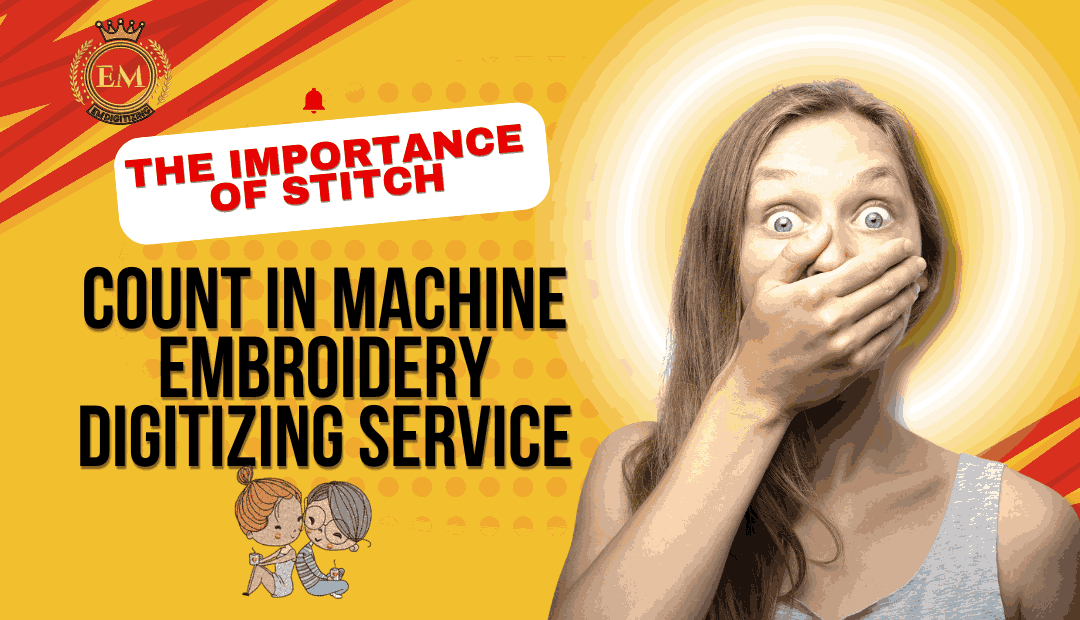In the embroidery industry, especially for startups and small fashion brands, one detail can make a significant difference: stitch count. Whether you’re digitizing logos for t-shirts, caps, jackets, or tote bags, the total number of stitches in your design affects cost, quality, production speed, and even the comfort of the garment.
When using a professional machine embroidery digitizing service, stitch count isn’t just a number—it’s a strategic decision. It defines how efficiently your designs translate into final embroidered products. This blog explores the importance of stitch count and how mastering it leads to better results and smarter spending.
What Is Stitch Count?
Stitch count refers to the total number of stitches an embroidery machine will make to complete a design. During the digitizing process, when your artwork is converted into a machine-readable file (like DST, PES, or EXP), the number of stitches is determined based on design size, stitch type, fabric, and detailing.
For example, a 3-inch logo on a polo shirt might require 6,000–10,000 stitches depending on how detailed the design is. A back design for a denim jacket could easily reach over 60,000 stitches.
Understanding and managing stitch count is one of the core responsibilities of any high-quality machine embroidery digitizing service.
Why Stitch Count Matters in Costing
Most embroidery service providers charge based on stitch count. The more stitches in a design, the more time and thread it takes to complete it. This directly increases production cost.
For example:
- 5,000 stitches = approx. $5
- 10,000 stitches = approx. $8
- 25,000+ stitches = $15 or more (based on design and quantity)
Fashion startups looking to scale need designs that are both visually appealing and cost-efficient. An optimized stitch count makes that possible.
By choosing a trusted provider like EMDigitizing, brands can rest assured that every stitch is calculated for maximum efficiency helping keep embroidery costs manageable.
Stitch Count and Production Time
Every embroidery machine has a stitching speed (usually 600–1,000 stitches per minute). That means:
- A 10,000-stitch design = 10–15 minutes per piece
- A 30,000-stitch design = 30–45 minutes per piece
Now multiply that by a batch of 100 garments. Suddenly, optimizing stitch count becomes a major factor in production scheduling.
If you’re running promotional merchandise or preparing uniforms for a retail launch, even a few thousand stitches saved per item can speed up delivery by days.
Impact on Design Quality and Fabric Compatibility
Too few stitches and your design can look empty or unfinished. Too many, and it might cause puckering, stiffness, or even tear lightweight fabrics. This is where a professional machine embroidery digitizing service really proves its value.
A skilled digitizer uses a balance of:
- Stitch types (satin, fill, run)
- Density and spacing
- Fabric-specific settings
- Pull compensation
- Underlay stitch strategy
All these factors together ensure that the stitch count complements both the design and the garment it’s applied to.
For example:
- Cotton polos handle medium stitch density well
- Canvas or denim support high stitch counts
- Stretchy performance wear needs lower stitch counts to avoid distortion
Stitch Count and Garment Feel
Consumers don’t just see embroidery—they feel it. A densely stitched logo on the chest of a t-shirt can feel heavy or stiff, especially during warm weather. Excessive stitch count makes embroidery patches bulky and rigid, which could lead to discomfort.
Reducing stitch count can make the final embroidery feel softer, more breathable, and more wearable—without sacrificing visual appeal. That’s why experienced brands opt for a professional machine embroidery digitizing service that focuses on comfort just as much as design clarity.
Estimating Stitch Count Before Production
You don’t have to guess stitch count blindly. Experienced digitizers can give you an estimate based on your design’s size and detail. Here’s a general guide:
| Design Area | Approximate Stitch Count |
|---|---|
| Left chest logo (3″x3″) | 6,000 – 10,000 stitches |
| Cap front | 5,000 – 8,000 stitches |
| Jacket back | 50,000 – 100,000 stitches |
| Text only (1–2 words) | 2,000 – 4,000 stitches |
Remember: it’s not just size that matters—it’s also complexity, number of color changes, and how the stitches are digitized.
Techniques Used to Optimize Stitch Count
Professionals use a range of strategies to reduce stitch count without hurting design quality:
1. Efficient Fill Patterns
Fill stitches are dense and heavy. Replacing them with run or satin stitches in appropriate places saves thousands of stitches.
2. Controlled Stitch Density
By adjusting the spacing between stitches, you can reduce stitch load while keeping the design legible and balanced.
3. Clean Pathing
Good digitizers reduce unnecessary “jump stitches” and trims. This minimizes wasted thread and shortens production time.
4. Smarter Underlay Settings
Instead of defaulting to heavy underlays, professional digitizers customize stabilizing stitches based on fabric behavior.
These practices are common among elite providers such as EMDigitizing, who deliver precision stitch files optimized for speed, comfort, and detail.
Stitch Count in Reusability and Scaling
Once your logo or design is digitized with an optimized stitch count, it becomes a reusable digital asset. Whether you apply it to t-shirts, caps, bags, or jackets, the same file can be used repeatedly across materials and vendors.
For scaling up:
- Fewer stitches = faster runs
- Faster runs = higher output per day
- Higher output = better cost efficiency
That’s why most growing fashion startups invest in high-quality digitized files early on. It sets them up for scalable growth and consistent branding.
Common Myths About Stitch Count
❌ More stitches mean higher quality
Not always. Overly dense stitching can ruin both the design and the garment.
❌ Lower stitch count equals poor design
Again, false. A good design with smart spacing and efficient pathing can look professional even with fewer stitches.
❌ Stitch count doesn’t affect customer experience
It does. Embroidered designs with too many stitches can feel heavy and hot, affecting comfort and wearability.
Stitch Count and Logo Embroidery
Logo digitizing is one of the most common use cases for embroidery. For fashion labels, sports teams, and corporate branding, embroidery offers a polished and professional look.
When done right, your logo becomes:
- Crisp and readable
- Balanced in color and spacing
- Soft and wearable
But all that depends on stitch count. If your logo is 3,000 stitches too dense, you could be spending more, slowing down production, and reducing garment comfort—all without realizing it.
Using a machine embroidery digitizing service ensures your logo gets translated into thread in the most efficient way possible.
Choosing the Right Digitizing Partner
Not all digitizing services are equal. When choosing a provider, consider:
- Experience with different fabrics and garments
- Ability to provide files in multiple formats (DST, PES, etc.)
- Focus on stitch optimization and run-time reduction
- Quick turnaround and revisions
If you’re a fashion startup, working with specialists like the team at EMDigitizing helps ensure you get both quality and cost efficiency.
Real-World Example
A streetwear startup planned a 500-unit hoodie drop with an oversized chest design. Their initial file contained 45,000 stitches, making each hoodie cost nearly $20 just for embroidery. After getting the file re-digitized to reduce the stitch count to 28,000 without visual loss, the unit embroidery cost dropped to $12. That’s a $4,000+ saving across one drop—purely from stitch optimization.
Conclusion
Stitch count is more than just a technical detail—it’s the heart of cost, comfort, and production efficiency in embroidery. For anyone using a machine embroidery digitizing service, understanding how stitch count works will empower better business decisions, higher-quality products, and faster scaling.
Whether you’re launching your first apparel line or scaling up production, always prioritize optimized digitizing. Every stitch counts—literally.
FAQs
Q1: What is considered a high stitch count?
Any design over 25,000 stitches is considered high and requires evaluation for efficiency and fabric compatibility.
Q2: Does reducing stitch count affect design clarity?
Not if done professionally. A good digitizer maintains clarity while minimizing density.
Q3: How can I reduce stitch count for my logo?
Use smart digitizing techniques like lighter underlay, proper fill types, and clean pathing.
Q4: What’s the average stitch count for cap logos?
Between 5,000 and 8,000 stitches depending on the design and size.
Q5: Should I digitize separately for each fabric?
Ideally, yes. A good digitizer adjusts stitch count and technique based on fabric type.



